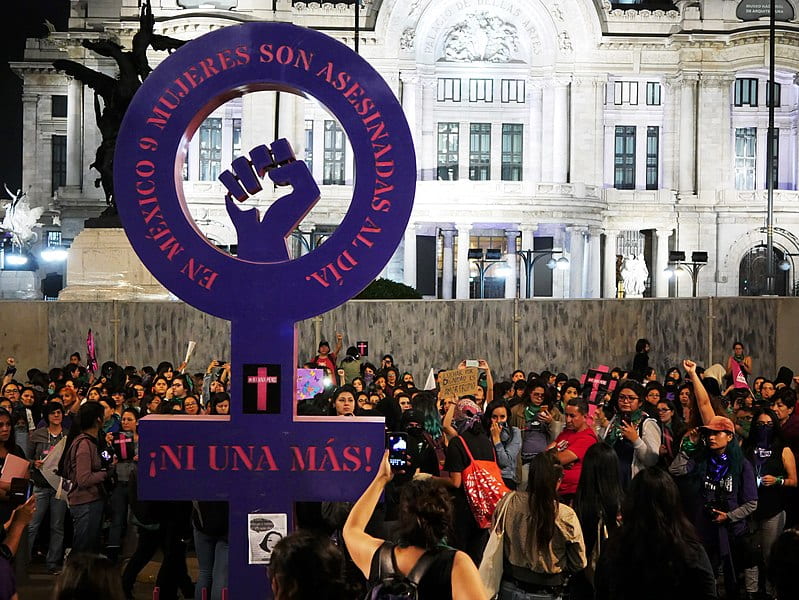On Monday March 9th, 2020, thousands of women in Mexico did not go to work as protest for the increasing rates of femicide and gender inequality in the country.[1] They called it a day without women and by not participating in public life, they demonstrated that daily life could not function without them present.[2] This is not the first time women in Mexico have called out the government on its inability to keep them safe. Women and girls in Mexico continue to face a disturbing amount of gender-based violence. According to the 2020 world report from the Human Rights Watch, in the first 6 months of 2019, there were 540 femicides and the country had recorded at least 9,522 women and girls as missing.[3] The protests this month are another warning to the government that if they remain complacent as the number of victims of femicide continues to grow and nothing is done to stop the violence there will be consequences. Their failure to protect women will result in further counteraction and criticism from their population and the global community.
Femicide is a term that refers to the murder of a woman because they are a woman. Mexican law defines it “as depriving a woman of her life based on her gender”.[4] Latin American feminists first adopted the term in the 1990’s to define the increasing number of women being attacked and murdered in Juarez, Mexico.[5] In 2018 the United Nations (UN) Gender Equality observatory for Latin America and the Caribbean, Mexico reported 898 femicides, the second highest total, after Brazil, out of the 19 countries recorded.[6] And it is likely that these numbers are higher because gender based crimes are frequently under-reported.[7] When there is nothing being done to change the culture regarding femicide and perpetrators frequently are allowed to walk free, women are less likely to come forward out of feelings of hopelessness and fears of retaliation. This crisis will persist if there are no changes in government enforcement and societal attitudes.
Mexico’s current president, Andrés Manuel López Obrador, has done nothing to amend the situation. His dismissive position is exacerbating the issues. In 2019, during an interview he did not want to talk about “gender-motivated killings of women” because it would distract from the other activities he was engaged in at the time.[8] Since he has been in office, he has cut aid for shelters that assist abused women and funding for hundreds of organizations that work to protect victims of gendered violence.[9] Limiting resources for women in Mexico makes them more dependent on potential abusers in their life. By making it harder for them to escape dangerous home life situations, the government is increasing the likelihood of those situations escalating and leading to more deaths. Even though he and his administration have made little progress in addressing femicide, Obrador claims that the problem is a product of “neoliberalism” and that his administration is helping by preaching good Christian values and encouraging citizens to “love thy neighbor”.[10] But speaking out against femicide is not enough. The president and his administration need to take action by updating and clarifying Mexico’s policies and laws on murder and femicide and then actually implementing strategies to enforce those laws and end impunity.
Societal attitudes are also to blame for Mexico’s increasing rate of femicide. Machismo is an idea of toxic masculinity prevalent in Mexican culture that idolizes sexually aggressive men and casts women as inferior.[11] This contributes to the power imbalance between men and women and restricts women’s freedom over their lives and bodies. The Mexican media tends to play into the Machismo culture and romanticizes sexual violence.[12] In 2019, one of the murders that sparked protest and made headlines was that of 25 year old Ingrid Escamilla, who was murdered by her boyfriend in her apartment.[13] The media published crime scene photos of her disfigured corpse and captioned it with a popular love song lyric “Cupid was to blame.”[14] Showing graphic images of her murder and characterizing it as a product of love gone wrong desensitizes the public and rationalizes femicide. Portraying domestic abuse and homicide as a normal aspect of relationships allows the cases to be dismissed as less serious than other crimes. When femicide, rape, and domestic abuse are allowed to go on without consequence, the Mexican government and public are sending the message that they do not value the lives of the women and girls in their country.
Mexico has ratified Human Rights protocols designed to improve the lives of women from the UN, such as The Convention on the Elimination of all Forms of Discrimination Against Women (CEDAW).[15] However, they do not act in compliance with the principles expressed in the treaty. They were the first Latin American country to consider criminalizing femicide, and in 2012 under Article 325 of the Federal Criminal Code, it became codified in their law as a crime.[16] This was a major step in the right direction for dealing with the femicide crisis. However, there is not a uniform understanding of the law across all the states. Out of the 33 states in the country, only 15 specifically address femicide in their criminal codes.[17] They have different definitions of what qualifies as femicide and often, because of the sexist attitudes surrounding it, under report these heinous crimes.
In 2009 the Inter-American Court of Human Rights ruled that Mexico had failed to properly investigate femicides in Juarez, and therefore did not protect the victim’s human rights.[18] The court hoped that this would push Mexico to do something about the increasing number of murders and properly punish those responsible, but it is now 11 years later, and impunity still prevails. The Spotlight Initiative, a UN organization dedicated to ending violence against women, is working in Latin America in an attempt to change policy and societal attitudes that allow for the perpetuation of violence.[19] They may be making progress, but the laws are meaningless if they are not enforced. The Mexican government needs to stop turning a blind eye to perpetrators and actually implement strategies to support and protect the women and girls in the country.
In May 2020, Mexico will host the UN Women’s Generation Equality Forum.[20] It will be important to watch how the Obrador administration acts during the conference. Most likely they will act as though they are on top of the situation and prioritizing women’s rights. Unless they begin to make legitimate efforts to end impunity and stop the femicides they will be exposing the disconnect between the administration’s rhetoric and their lack of effort domestically to end gender violence. For any progress to be made, the government needs to be actively involved, rather than playing the role of a complicit bystander. Now is the time to take action and fulfill the international obligations they agreed to. The laws need to be enforced uniformly and perpetrators can no longer be allowed to evade conviction. Gender-based prejudices have to be addressed and dealt with. Mexico cannot continue to ignore the women and girls protesting for their rights, nor the increasing number of femicides happening everyday.
[1] Averbuch, Maya. “’We’ll Disappear’: Thousands of Mexican Women Strike to Protest Femicide.” The Guardian. Guardian News and Media, March 9, 2020. https://www.theguardian.com/world/2020/mar/09/thousands-mexican-women-protest-violence-murders-femicide-government-inaction.
[2] Averbuch, Maya. “’We’ll Disappear’: Thousands of Mexican Women Strike to Protest Femicide.” ide-government-inaction.
[3] Roth, Kenneth. “World Report 2020: Rights Trends in Mexico.” Human Rights Watch, January 14, 2020. https://www.hrw.org/world-report/2020/country-chapters/mexico.
[4] Roth, Kenneth. “World Report 2020: Rights Trends in Mexico.”
[5] García, Del Moral, Paulina, and Pamela Neumann. “The Making and Unmaking of Feminicidio/Femicidio Laws in Mexico and Nicaragua.” Law & Society Review 53, no. 2 (June 2019): 452–86. doi:10.1111/lasr.12380.
[6] Gender Equality Observatory for Latin America and the Caribbean. “Femicide or feminicide.” 2018. https://oig.cepal.org/en/indicators/femicide-or-feminicide
[7] Roth, Kenneth. “World Report 2020: Rights Trends in Mexico.”
[8] Vivanco, José Miguel. “Mexican Government Paralyzed in the Face of a Wave of Femicides.” Human Rights Watch, March 4, 2020. https://www.hrw.org/news/2020/03/03/mexican-government-paralyzed-face-wave-femicides.
[9] Cholbi, Isabel. “Femicide in Mexico: What Happens When the State Looks the Other Way.” Berkeley Political Review, April 17, 2019. https://bpr.berkeley.edu/2019/04/17/femicide-in-mexico-what-happens-when-the-state-looks-the-other-way/.
[10] Vivanco, José Miguel. “Mexican Government Paralyzed in the Face of a Wave of Femicides.”
[11] Ortiz, Veronica Lira. “The Culture of Machismo in Mexico Harms Women.” Merion West, December 31, 2018. https://merionwest.com/2018/01/28/the-culture-of-machismo-in-mexico-harms-women/.
[12] Vivanco, José Miguel. “Mexican Government Paralyzed in the Face of a Wave of Femicides.”
[13] Vivanco, José Miguel. “Mexican Government Paralyzed in the Face of a Wave of Femicides.”
[14] Vivanco, José Miguel. “Mexican Government Paralyzed in the Face of a Wave of Femicides.”
[15] García, Del Moral, Paulina, and Pamela Neumann. “The Making and Unmaking of Feminicidio/Femicidio Laws in Mexico and Nicaragua.”
[16] García, Del Moral, Paulina, and Pamela Neumann. “The Making and Unmaking of Feminicidio/Femicidio Laws in Mexico and Nicaragua.”
[17] García, Del Moral, Paulina, and Pamela Neumann. “The Making and Unmaking of Feminicidio/Femicidio Laws in Mexico and Nicaragua.”
[18] García, Del Moral, Paulina, and Pamela Neumann. “The Making and Unmaking of Feminicidio/Femicidio Laws in Mexico and Nicaragua.”
[19] Spotlight Initiative. United Nations, October 15, 2018. https://www.bing.com/videos/search?q=what+is+femicide&view=detail&mid=09EA83B9DA42AE0D3B4109EA83B9DA42AE0D3B41&FORM=VIRE.
[20] “Generation Equality Forum:Realizing Women’s Rights for an Equal Future.” UN Women. Accessed March 20, 2020. https://www.unwomen.org/en/get-involved/beijing-plus-25/generation-equality-forum.







